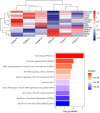Gene Expression Signatures of Contact Lens-Induced Myopia in Guinea Pig Retinal Pigment Epithelium
- PMID: 36006019
- PMCID: PMC9424971
- DOI: 10.1167/iovs.63.9.25
Gene Expression Signatures of Contact Lens-Induced Myopia in Guinea Pig Retinal Pigment Epithelium
Abstract
Purpose: To identify key retinal pigment epithelium (RPE) genes linked to the induction of myopia in guinea pigs.
Methods: To induce myopia, two-week-old pigmented guinea pigs (New Zealand strain, n = 5) wore -10 diopter (D) rigid gas-permeable contact lenses (CLs), for one day; fellow eyes were left without CLs and served as controls. Spherical equivalent refractive errors (SE) and axial length (AL) were measured at baseline and one day after initiation of CL wear. RNA sequencing was applied to RPE collected from both treated and fellow (control) eyes after one day of CL-wear to identify related gene expression changes. Additional RPE-RNA samples from treated and fellow eyes were subjected to quantitative real-time PCR (qRT-PCR) analysis for validation purposes.
Results: The CLs induced myopia. The change from baseline values in SE was significantly different (P = 0.016), whereas there was no significant difference in the change in AL (P = 0.10). RNA sequencing revealed significant interocular differences in the expression in RPE of 13 genes: eight genes were significantly upregulated in treated eyes relative to their fellows, and five genes, including bone morphogenetic protein 2 (Bmp2), were significantly downregulated. The latter result was also confirmed by qRT-PCR. Additional analysis of differentially expressed genes revealed significant enrichment for bone morphogenetic protein (BMP) and TGF-β signaling pathways.
Conclusions: The results of this RPE gene expression study provide further supporting evidence for an important role of BMP2 in eye growth regulation, here from a guinea pig myopia model.
Conflict of interest statement
Disclosure:
Figures




Similar articles
-
Changes in Expression in BMP2 and Two Closely Related Genes in Guinea Pig Retinal Pigment Epithelium during Induction and Recovery from Myopia.Biomolecules. 2023 Sep 11;13(9):1373. doi: 10.3390/biom13091373. Biomolecules. 2023. PMID: 37759773 Free PMC article.
-
Altered gene expression in tree shrew retina and retinal pigment epithelium produced by short periods of minus-lens wear.Exp Eye Res. 2018 Mar;168:77-88. doi: 10.1016/j.exer.2018.01.005. Epub 2018 Jan 9. Exp Eye Res. 2018. PMID: 29329973 Free PMC article.
-
Altered Expression of GJD2 Messenger RNA and the Coded Protein Connexin 36 in Negative Lens-induced Myopia of Guinea Pigs.Optom Vis Sci. 2020 Dec;97(12):1080-1088. doi: 10.1097/OPX.0000000000001611. Optom Vis Sci. 2020. PMID: 33278187 Free PMC article.
-
Interventions to slow progression of myopia in children.Cochrane Database Syst Rev. 2020 Jan 13;1(1):CD004916. doi: 10.1002/14651858.CD004916.pub4. Cochrane Database Syst Rev. 2020. PMID: 31930781 Free PMC article.
-
The Role of Retinal Dysfunction in Myopia Development.Cell Mol Neurobiol. 2023 Jul;43(5):1905-1930. doi: 10.1007/s10571-022-01309-1. Epub 2022 Nov 24. Cell Mol Neurobiol. 2023. PMID: 36427109 Free PMC article. Review.
Cited by
-
Prevalence and Characteristics of Myopia in Adult Rhesus Macaques in Southwest China.Transl Vis Sci Technol. 2023 Mar 1;12(3):21. doi: 10.1167/tvst.12.3.21. Transl Vis Sci Technol. 2023. PMID: 36947048 Free PMC article.
-
Refractive Development and Choroidal Vascularity in the Form-Deprivation Pigmented Rabbit Model.Transl Vis Sci Technol. 2025 Feb 3;14(2):18. doi: 10.1167/tvst.14.2.18. Transl Vis Sci Technol. 2025. PMID: 39946105 Free PMC article.
-
Dynamic BMP gene expression regulation in chick RPE during recovery from short term optical defocus and form-deprivation.PLoS One. 2024 Oct 11;19(10):e0311505. doi: 10.1371/journal.pone.0311505. eCollection 2024. PLoS One. 2024. PMID: 39392817 Free PMC article.
-
Encephalopsin (OPN3) is required for normal refractive development and the GO/GROW response to induced myopia.Mol Vis. 2023 May 14;29:39-57. eCollection 2023. Mol Vis. 2023. PMID: 37287644 Free PMC article.
-
Changes in Expression in BMP2 and Two Closely Related Genes in Guinea Pig Retinal Pigment Epithelium during Induction and Recovery from Myopia.Biomolecules. 2023 Sep 11;13(9):1373. doi: 10.3390/biom13091373. Biomolecules. 2023. PMID: 37759773 Free PMC article.
References
-
- Holden BA, Fricke TR, Wilson DA, et al. .. Global prevalence of myopia and high myopia and temporal trends from 2000 through 2050. Ophthalmology. 2016; 123: 1036–1042. - PubMed
-
- Dolgin E. The myopia boom. Nature. 2015; 519(7543): 276–278. - PubMed
-
- Flitcroft DI. The complex interactions of retinal, optical and environmental factors in myopia aetiology. Prog Retin Eye Res. 2012; 31: 622–660. - PubMed
-
- Seko Y, Shimizu M, Tokoro T.. Retinoic acid increases in the retina of the chick with form deprivation myopia. Ophthalmic Res. 1998; 30: 361–367. - PubMed

